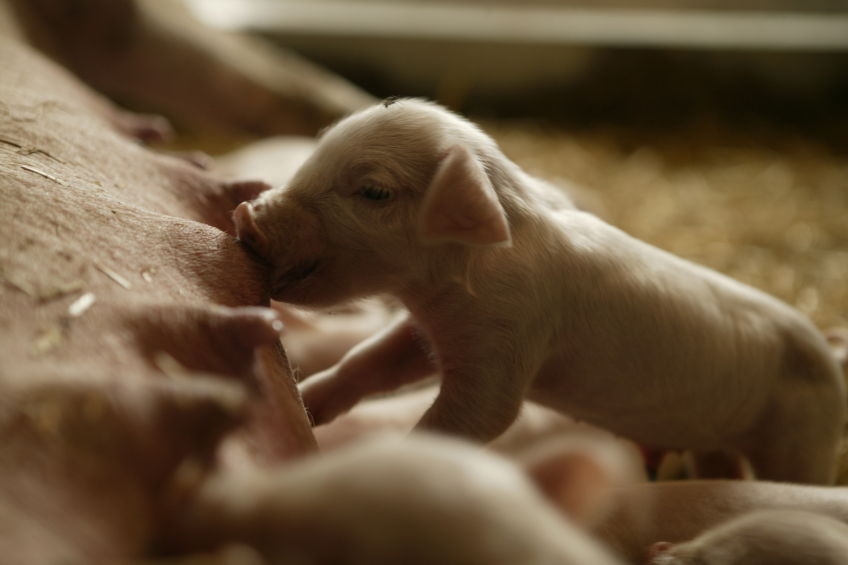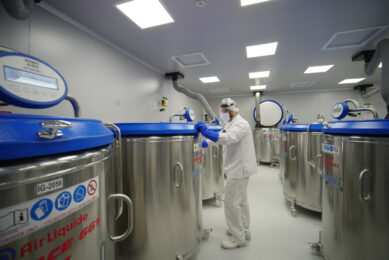A healthy piglet starts with a healthy sow

When aiming for the best health for piglets, pork producers should definitely take the ?piglets’ mothers into account as well. There is simply too much happening in and around sows to ignore, that can affect their offspring’s health situation.
By Dr Isabelle Le Huërou-Luron , senior scientist, INRA, Saint-Gilles, France
The environment can influence developmental plasticity and thus phenotypes in a wide variety of animals, from insect to man. The concept that developmental insults (poor or inadequate pre-or postnatal nutrition for example) can have long-term consequences on health of the offspring has been called developmental programming, or Developmental Origins of Health and Disease (DOHaD). Human epidemiological studies have provided convincing support for this DOHaD concept by initially showing a strong association between low birth weight and increased risk of health complications throughout their lifespan, including a range of metabolic, neurological, behavioural and reproductive disorders.
Other environmental problems such as exposure to stress, toxins, high temperatures, changes in maternal nutrition during pregnancy or during the neonatal period, may alter the early development of specific organs in offspring that in turn, influence the adult phenotype. The environment may have a much broader impact on the adult phenotype when the marks occur early during development.
Shared by livestock
DOHaD mechanisms are shared by livestock. Maternal nutrition status is implicated in nutrient partitioning between organs and thereby modulates growth, development and functions of foetal organs. Several factors may induce a poor nutritional environment during foetal life. For example, the breeding of young dams may lead to competition for nutrients between the rapidly growing maternal systems or the demand for milk production and foetal and placental growth. Selection for large litter sizes in pigs is associated with reduced foetal size. With the current global climatic changes, temperature fluctuations are likely to cause irregularity in the quantity of forage and cereal yield and to induce quantitative and qualitative variations in the diet provided to the animals with short or even long term periods of nutritional restriction.
As in humans, compromised foetal or neonatal growth has been shown to result in increased neonatal morbidity and mortality, lower postnatal growth rates, poor body composition including increased fat, reduced muscle growth and lower meat quality, long-term metabolic disorders, lower fertility and dysfunction of specific organs in most of species studied.
Concerning pig production, the average litter size of sows has been increased by genetic selection over the last decade. It has been associated with a reduction in the mean piglet birth weight and, concomitantly, with an increased within-litter variation in birth weight leading to a rise in the proportion of small piglets (less than 1 kg birth weight) in large litters. Pigs with low birth weight exhibited consistently lower postnatal growth rates.
Growth failure
Growth failure is partly explained by the reduced intestinal size and the lower intestinal trophic responses to enteral food introduction during the early postnatal period. Long-term consequences are lower lean carcass percentages and meat quality than those of normal or heavy birth weight littermates at slaughter. Characteristics of the gut microbiota and binding property of intestinal mucosa to luminal bacteria are also affected in pigs with low birth weight. After weaning, striking differences are seen in the fermentative activity of the caecum, with greater acetate and propionate concentrations compared with normal birth weight pigs.
Such differences may be of importance throughout life as it is well known that the commensal microbiota is pivotal for degradation of otherwise indigestible complex carbohydrates. Gut bacteria directly modulate the utilisation of food, implying that the true caloric value of feed is variable depending on the microbiota composition and its ability to mobilise potential energy sources for the host. These observations emphasise the importance of understanding how to manage from compromised pregnancies.
Additionally, it has been shown that developmental insults in one generation can have consequences for later generations even in absence of further insults. Such long-term effects may depend on epigenetic alterations. Nutritional strategies such as protein supplementation, amino acids or oligo-element supplementation may protect, in some cases, foetal or neonatal organ systems from the negative effects of dietary restriction during pregnancy.
Intestinal microbiota
Establishment of the intestinal microbiota after birth plays an important role in the development of the neonatal gut and its immune system. It appears that the mother’s microbiota is shared to a large degree by the offspring during the first days of postnatal life. Therefore, maternal environmental factors (diet composition, antibiotic treatment, etc.) that induce changes in maternal microbiota may have huge effects on offspring gut physiology. There is no doubt of the essential early contact of the neonate with environmental and colonising bacteria for healthy intestinal and immune maturation. Studies with germ-free piglets clearly show that bacteria are essential to growth and development of the digestive tract. Composition of the microbiota in healthy individuals is rather unique and appears to be quite stable after initial colonisation. Nevertheless, early disturbances of the microbial colonisation process, such as those induced by the hygienic status of the rearing environment and by antibiotic treatment of sows, have drastic consequences for the developmental programme of the offspring’s gut. This concern is relevant to swine production as antibiotics are frequently used for controlling infections of the genito-urinary tract and mammary gland peri- or post-partum in sows.
Comparing different early environmental-rearing conditions, outdoor and indoor sow-reared piglets or isolator-reared neonates, showed large differences in composition of ileal-adherent microbiota between outdoor and indoor sow-reared animals which corresponded to major differences in gut immune activation.
Excessive hygiene appears to interfere with the normal processes of bacterial stabilisation and alters immune development. Deleterious effects of maternal antibiotic treatment have recently also been demonstrated in sow microbiota and that of their newborn offspring. The piglets’ intestinal functions were also noticeably effected by environmental factors. Ileal and colonic permeability, epithelial transcriptome and mucosal inflammation characteristics were modified toward a pro-inflammatory response to an LPS challenge when mothers were given antibiotic treatment.
It was also shown that early manipulation of the mothers’ microbiota by antibiotics deeply influenced the intestinal adaptive response to a high-fat diet in adult offspring, suggesting a microbiota imprinting in gut response to high-fat diet. Therefore gut microbiota could be a player in programming as its initial composition is thought to be sustainably modifed during lifespan.
Substrates
Specific substrates can be included in the diet to stimulate the growth of assumed beneficial bacteria and prevent the growth and colonisation of potential pathogens. These are known as prebiotics and they include dietary fibres, resistant starch, and oligosaccharides. Benefits of feeding high-fibre diets to sows during late pregnancy and lactation were also observed in early piglet growth, colostrum intake of low birth weight piglets, and litter performance. Long-term effects have also been shown concerning gut functions and sensitivity to inflammatory challenge. Interestingly, recent studies provide strong support for the idea that short dietary changes before weaning associated with a modification of the early intestinal bacterial colonisation, can have a long-term impact on the severity of inflammatory response without changing the basal physiology of barrier function and cytokine profile in the intestine.
Epigenetic mechanisms
Through a better understanding of the effects and of the epigenetic mechanisms involved in DOHaD, in addition to the careful use of animal genetic selection, both animal production and welfare can be improved and some of the negative effects of feedstuff restriction could be prevented. A better understanding of the long-term effects of neonate environment and of the epigenetic mechanisms involved, as well as careful use of animal genetic selection, could improve animal production and health later in life.
References are available on request.
Source: Pig Progress magazine Volume 30.7 (2014)











